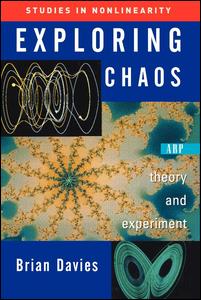

Most ebook files are in PDF format, so you can easily read them using various software such as Foxit Reader or directly on the Google Chrome browser.
Some ebook files are released by publishers in other formats such as .awz, .mobi, .epub, .fb2, etc. You may need to install specific software to read these formats on mobile/PC, such as Calibre.
Please read the tutorial at this link. https://ebooknice.com/page/post?id=faq
We offer FREE conversion to the popular formats you request; however, this may take some time. Therefore, right after payment, please email us, and we will try to provide the service as quickly as possible.
For some exceptional file formats or broken links (if any), please refrain from opening any disputes. Instead, email us first, and we will try to assist within a maximum of 6 hours.
EbookNice Team

Status:
Available4.4
9 reviews
ISBN-10 : 0367314126
ISBN-13 : 9780367314125
Author: Brian Davies
This book presents elements of the theory of chaos in dynamical systems in a framework of theoretical understanding coupled with numerical and graphical experimentation. It describes the theory of fractals, focusing on the importance of scaling and ordinary differential equations.
1 Introduction
1.1 Dynamical models
1.2 Celestial mechanics
1.3 Lorenz: the end of weather prediction?
1.4 Complex behaviour of simple systems
2 Orbits of one-dimensional systems
2.1 Discrete dynamical systems
2.2 Fixed points and stability
2.3 Some orbits of the tent map
2.4 Period doubling of the logistic map
2.5 Periodic orbits and compositions
2.6 The fully chaotic tent map
2.7 Numerical versus exact orbits
2.8 Fourier analysis of an orbit
2.9 Lyapunov exponent of an orbit
2.10 Chaotic orbits
2.11 Ergodic orbits
3 Bifurcations in one-dimensional systems
3.1 Bifurcation diagrams
3.2 Final state diagrams
3.3 Period doubling mechanism
3.4 Period doubling cascades
3.5 Feigenbaum’s universal constants
3.6 Tangent bifurcations
3.7 Intermittent behaviour
3.8 Unstable orbits and crises
3.9 Transcritical and pitchfork bifurcations
3.10 Theory of Feigenbaum scaling
4 Two-dimensional systems
4.1 The Hénon map
4.2 Fixed points
4.3 Area contraction
4.4 Stability of fixed points
4.5 Periodic orbits
4.6 Lyapunov exponents
4.7 Basin boundaries
4.8 Linear feedback and control
4.9 Tangent bifurcations and zero curves
4.10 Producing the strange attractor
5 Fractals
5.1 The Hénon attractor
5.2 The Cantor Set
5.3 Fractal bifurcation diagrams
5.4 Capacity dimension
5.5 Capacity dimension of the Hénon attractor
5.6 Self-similar fractals
5.7 Lyapunov dimension of two-dimensional maps
5.8 The Rössler attractor
5.9 The Feigenbaum attractor
6 Non-linear oscillations
6.1 The driven non-linear pendulum
6.2 Phase Plane
6.3 Poincaré sections
6.4 Lyapunov exponents
exploring chaos theory and experiment
chaos theory effect
chaos theory applications
chaos theory simple terms
chaos theory explained
Tags: Exploring Chaos, Theory, Experiment, Brian Davies